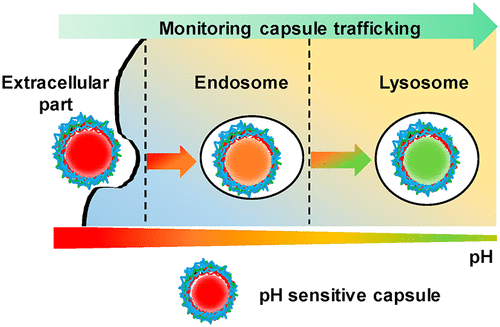Our official English website, www.x-mol.net, welcomes your
feedback! (Note: you will need to create a separate account there.)
Lysosomal Proton Buffering of Poly(ethylenimine) Measured In Situ by Fluorescent pH-Sensor Microcapsules.
ACS Nano ( IF 15.8 ) Pub Date : 2020-06-22 , DOI: 10.1021/acsnano.9b10219 Sathi Roy 1 , Dingcheng Zhu 1 , Wolfgang J Parak 1, 2 , Neus Feliu 1
ACS Nano ( IF 15.8 ) Pub Date : 2020-06-22 , DOI: 10.1021/acsnano.9b10219 Sathi Roy 1 , Dingcheng Zhu 1 , Wolfgang J Parak 1, 2 , Neus Feliu 1
Affiliation

|
Poly(ethylenimine) (PEI) is frequently used as transfection agent for delivery of nucleic acids to the cytosol. After endocytosis of complexes of PEI and nucleic acids, a fraction of them can escape endosomes/lysosomes and reach the cytosol. One proposed mechanism is the so-called proton sponge effect, which involves buffering of the lysosomal pH by PEI. There are however also reports that report the absence of such buffering. In this work, the buffering capacity of PEI of the lysosomal pH was investigated in situ by combining PEI and pH-sensing ratiometric fluorophores in a single carrier particle. As carrier particles, hereby capsules were used, which were composed of polyelectrolyte walls based on layer-by-layer assembly, with the pH sensors located inside the capsule cavities. In this way, the local pH around individual particles could be monitored during the whole process of endocytosis. Results demonstrate the pH-buffering capability of PEI, which prevents the strong acidification of lysosomes containing PEI. This effect was related to the presence of PEI and was not related to the overall charge of the carrier particles. In case PEI was added in molecular form, no buffering of pH could be observed by endocytosed encapsulated pH-sensing ratiometric fluorophores. Co-localization experiments demonstrated that this was due to the fact that internalized free PEI and the encapsulated pH-sensing ratiometric fluorophores were not located in the same lysosomes. Missing co-localization might explain why also in other studies no pH buffering was found; in the case of co-delivery of PEI, the pH sensors could be clearly observed.
中文翻译:

聚(乙烯亚胺)的溶酶体质子缓冲通过荧光pH传感器微胶囊原位测量。
聚(乙烯亚胺)(PEI)通常用作将核酸递送至细胞质的转染剂。对PEI和核酸的复合物进行内吞后,它们中的一部分可以逃逸内体/溶酶体并到达胞质溶胶。一种提出的机制是所谓的质子海绵效应,其涉及通过PEI缓冲溶酶体pH。但是,也有报告指出没有这种缓冲。在这项工作中,原位研究了溶酶体pH的PEI的缓冲能力。通过在单个载体颗粒中结合PEI和pH传感比例荧光团。作为载体颗粒,在此使用胶囊,其由基于逐层组装的聚电解质壁组成,并且pH传感器位于胶囊腔内。这样,可以在整个内吞过程中监测单个颗粒周围的局部pH。结果证明了PEI的pH缓冲能力,可以阻止含有PEI的溶酶体的强酸化。该作用与PEI的存在有关,与载体颗粒的总电荷无关。如果以分子形式添加PEI,则通过内吞封装的pH传感比例荧光团无法观察到pH缓冲。共定位实验表明这是由于以下事实:内在化的游离PEI和封装的pH传感比例荧光团不在同一溶酶体中。缺少共定位可能解释了为什么在其他研究中也没有发现pH缓冲。如果与PEI一起交付,则可以清楚地观察到pH传感器。
更新日期:2020-07-28
中文翻译:

聚(乙烯亚胺)的溶酶体质子缓冲通过荧光pH传感器微胶囊原位测量。
聚(乙烯亚胺)(PEI)通常用作将核酸递送至细胞质的转染剂。对PEI和核酸的复合物进行内吞后,它们中的一部分可以逃逸内体/溶酶体并到达胞质溶胶。一种提出的机制是所谓的质子海绵效应,其涉及通过PEI缓冲溶酶体pH。但是,也有报告指出没有这种缓冲。在这项工作中,原位研究了溶酶体pH的PEI的缓冲能力。通过在单个载体颗粒中结合PEI和pH传感比例荧光团。作为载体颗粒,在此使用胶囊,其由基于逐层组装的聚电解质壁组成,并且pH传感器位于胶囊腔内。这样,可以在整个内吞过程中监测单个颗粒周围的局部pH。结果证明了PEI的pH缓冲能力,可以阻止含有PEI的溶酶体的强酸化。该作用与PEI的存在有关,与载体颗粒的总电荷无关。如果以分子形式添加PEI,则通过内吞封装的pH传感比例荧光团无法观察到pH缓冲。共定位实验表明这是由于以下事实:内在化的游离PEI和封装的pH传感比例荧光团不在同一溶酶体中。缺少共定位可能解释了为什么在其他研究中也没有发现pH缓冲。如果与PEI一起交付,则可以清楚地观察到pH传感器。









































 京公网安备 11010802027423号
京公网安备 11010802027423号